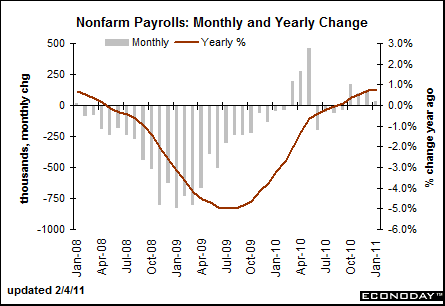A drop in the unemployment rate and upside revisions to prior months are helping investors overlook a big miss in headline payrolls for the month of January. Overall employment rose just 36,000 versus expectations of 140,000. December was revised higher to 121,000 while November was revised higher to 93,000. The unemployment rate declined, but this is largely due to a shrinking employment pool.
In a sort of sick way, this is the report the market was looking for. A very strong report would have likely scared markets a bit. As we saw in yesterday’s productivity report, this report means companies are maintaining high productivity, but keeping their margins high. On the other hand, it doesn’t bode well for the strength of the domestic recovery. And that likely means the Fed will continue to reassure the market by keeping “asset prices higher than they otherwise would be”. Econoday details the report:
“Today’s employment report is about as mixed as you can get. Payroll jobs are disappointingly anemic while the unemployment rate unexpectedly fell sharply. Overall payroll employment in January posted a minimal 36,000 increase, following a revised 121,000 gain in December and a 93,000 advance in November. The January boost fell short of analysts’ estimate for a 140,000 gain. The November and December revisions were down net 4,000. The private sector barely did little better than overall as private nonfarm payrolls increased 50,000 in January, down from a 121,000 boost the prior month. The consensus expected a 150,000 gain.
For the latest month, private service-providing jobs rose 32,000 after a 146,000 increase in December. Good-producing jobs rebounded 18,000, following a 7,000 decrease in December. Manufacturing is showing a boost in momentum as jobs jumped 49,000 after a 14,000 gain the month before. Construction likely was damped by adverse weather, falling 32,000 in January, following a 17,000 decline the prior month. Mining edged up 1,000 in January. Government jobs fell 14,000, following an 18,000 drop in December.
Wage gains improved in the latest month. Average hourly earnings in January rose 0.4 percent, following a 0.1 percent uptick the prior month. The January figure topped the market median estimate for a 0.2 percent increase. Most likely, the rise in earnings was due to the jump in manufacturing employment-in a high wage sector. The average workweek for all workers posted at 34.2 hours, compared to analysts’ forecast for 34.3 hours.
On a year-ago basis, overall payroll job growth rose to up 0.8 percent in January from up 0.7 percent in December.
Turning to the household survey, the unemployment rate fell to 9.0 percent from December’s unexpectedly low 9.4 percent. The market median estimate was for 9.5 percent. The drop was largely due to a drop in the labor force but household employment rose moderately.
Today’s report is baffling, given it contrasts so much with recent surveys showing gains in employment. Severe winter weather may have played a role in delaying hiring. The boost in manufacturing employment is encouraging and likely portends a general strengthening in demand for labor.”

Mr. Roche is the Founder and Chief Investment Officer of Discipline Funds.Discipline Funds is a low fee financial advisory firm with a focus on helping people be more disciplined with their finances.
He is also the author of Pragmatic Capitalism: What Every Investor Needs to Understand About Money and Finance, Understanding the Modern Monetary System and Understanding Modern Portfolio Construction.

Comments are closed.